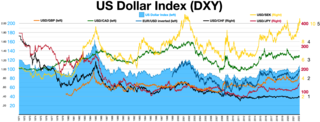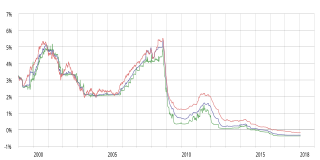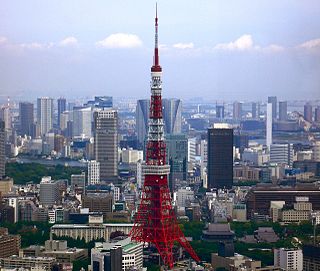Related Research Articles

The yen is the official currency of Japan. It is the third-most traded currency in the foreign exchange market, after the United States dollar (US$) and the euro. It is also widely used as a third reserve currency after the US dollar and the euro.

The Bank of Japan is the central bank of Japan. The bank is often called Nichigin (日銀) for short. It has its headquarters in Chūō, Tokyo.

The London Inter-Bank Offered Rate is an interest-rate average calculated from estimates submitted by the leading banks in London. Each bank estimates what it would be charged were it to borrow from other banks. The resulting average rate is usually abbreviated to Libor or LIBOR, or more officially to ICE LIBOR. It was formerly known as BBA Libor (for British Bankers' Association Libor or the trademark bba libor) before the responsibility for the administration was transferred to Intercontinental Exchange. It is the primary benchmark, along with the Euribor, for short-term interest rates around the world. Libor was phased out at the end of 2021, and market participants are being encouraged to transition to risk-free interest rates.

The foreign exchange market is a global decentralized or over-the-counter (OTC) market for the trading of currencies. This market determines foreign exchange rates for every currency. It includes all aspects of buying, selling and exchanging currencies at current or determined prices. In terms of trading volume, it is by far the largest market in the world, followed by the credit market.

The Euro Interbank Offered Rate (Euribor) is a daily reference rate, published by the European Money Markets Institute, based on the averaged interest rates at which Eurozone banks offer to lend unsecured funds to other banks in the euro wholesale money market. Prior to 2015, the rate was published by the European Banking Federation.
Eonia is computed as a weighted average of all overnight unsecured lending transactions in the interbank market, undertaken in the European Union and European Free Trade Association (EFTA) countries by the Panel Banks. It is reported on an ACT/360 day count convention and is displayed to three decimal places. "Overnight" means from one TARGET day to the next. The panel of reporting banks is the same as for Euribor, and a list is provided by the overseers of the publication of the index. There is no clear definition of 'interbank market' leading to the potential of subjective assessment of what is an 'interbank loan', albeit all panel banks are subject to the Eonia Code of Conduct.

In the United States, the federal funds rate is the interest rate at which depository institutions lend reserve balances to other depository institutions overnight on an uncollateralized basis. Reserve balances are amounts held at the Federal Reserve to maintain depository institutions' reserve requirements. Institutions with surplus balances in their accounts lend those balances to institutions in need of larger balances. The federal funds rate is an important benchmark in financial markets.
The discount window is an instrument of monetary policy that allows eligible institutions to borrow money from the central bank, usually on a short-term basis, to meet temporary shortages of liquidity caused by internal or external disruptions. The term originated with the practice of sending a bank representative to a reserve bank teller window when a bank needed to borrow money.
SONIA is the effective reference for overnight indexed swaps for unsecured transactions in the Sterling market. SONIA is a risk-free rate.

The Japanese asset price bubble was an economic bubble in Japan from 1986 to 1991 in which real estate and stock market prices were greatly inflated. In early 1992, this price bubble burst and Japan's economy stagnated. The bubble was characterized by rapid acceleration of asset prices and overheated economic activity, as well as an uncontrolled money supply and credit expansion. More specifically, over-confidence and speculation regarding asset and stock prices were closely associated with excessive monetary easing policy at the time. Through the creation of economic policies that cultivated the marketability of assets, eased the access to credit, and encouraged speculation, the Japanese government started a prolonged and exacerbated Japanese asset price bubble.
TIBOR stands for the Tokyo Interbank Offered Rate and is a daily reference rate based on the interest rates at which banks offer to lend unsecured funds to other banks in the Japan wholesale money market. TIBOR is published daily by the JBA TIBOR Administration.
The overnight rate is generally the interest rate that large banks use to borrow and lend from one another in the overnight market. In some countries, the overnight rate may be the rate targeted by the central bank to influence monetary policy. In most countries, the central bank is also a participant on the overnight lending market, and will lend or borrow money to some group of banks.
Hong Kong Inter-bank Offered Rate,, is the annualized rate charged for inter-bank lending on Hong Kong Dollar (HKD) denominated instruments, for a specified period ranging from overnight to one year. It is calculated daily at 11:00 a.m. local time based on quotations from 20 banks designated by the Hong Kong Association of Banks (HKAB).
The interbank lending market is a market in which banks lend funds to one another for a specified term. Most interbank loans are for maturities of one week or less, the majority being over day. Such loans are made at the interbank rate. A sharp decline in transaction volume in this market was a major contributing factor to the collapse of several financial institutions during the financial crisis of 2007–2008.
SARON stands for Swiss Average Rate Overnight and represents the overnight interest rate of the secured funding market for the Swiss Franc (CHF). is an overnight interest rates average referencing the Swiss Franc CHF. It is based on transactions and quotes posted in the Swiss repo market. SARON is administered by SIX.
The Libor scandal was a series of fraudulent actions connected to the Libor and also the resulting investigation and reaction. Libor is an average interest rate calculated through submissions of interest rates by major banks across the world. The scandal arose when it was discovered that banks were falsely inflating or deflating their rates so as to profit from trades, or to give the impression that they were more creditworthy than they were. Libor underpins approximately $350 trillion in derivatives. It is currently administered by Intercontinental Exchange (ICE), which took over running the Libor in January 2014.
Secured Overnight Financing Rate (SOFR) is a secured interbank overnight interest rate. SOFR is a reference rate established as an alternative to LIBOR. LIBOR has been published in a number of currencies and underpins financial contracts all over the world. Because LIBOR is derived from banks' daily quotes of borrowing costs, banks were able to manipulate the rates through lying in the surveys. Deeming it prone to manipulation, UK regulators decided to discontinue LIBOR in 2021.
Tokyo Overnight Average Rate or Uncollateralized Overnight Call Rate is an unsecured interbank overnight interest rate and reference rate for Japanese yen. Mutan rate and TONA rate are the same things.

On 20 February 2020, stock markets across the world suddenly crashed after growing instability due to the COVID-19 pandemic. It ended on 7 April 2020.

On September 17, 2019, interest rates on overnight repurchase agreements, which are short-term loans between financial institutions, experienced a sudden and unexpected spike. A measure of the interest rate on overnight repos in the United States, the Secured Overnight Financing Rate (SOFR), increased from 2.43% on September 16 to 5.25% on September 17. During the trading day, interest rates reached as high as 10%. The activity also affected the interest rates on unsecured loans between financial institutions, and the Effective Federal Funds Rate (EFFR), which serves as a measure for such interest rates, moved above its target range determined by the Federal Reserve.
References
- ↑ BOJ's Main Time-series Statistics
- ↑ "Change in the smallest tick in uncollateralized overnight call rate". Bank of Japan. September 6, 2001. Retrieved June 25, 2012.
- ↑ "Revision of the publication of "Uncollateralized overnight call rates (average)". Bank of Japan. September 6, 2002. Retrieved June 25, 2012.
- ↑ "Release of the Data Related to the Bank's Operations and Uncollateralized Overnight Call Rate". Bank of Japan. May 6, 2004. Retrieved June 25, 2012.